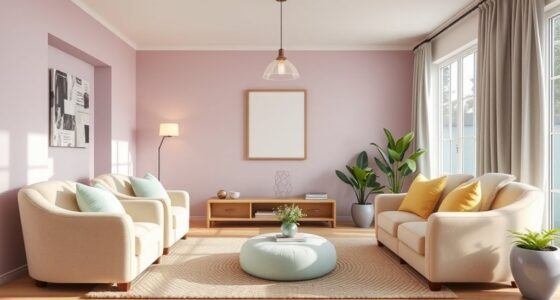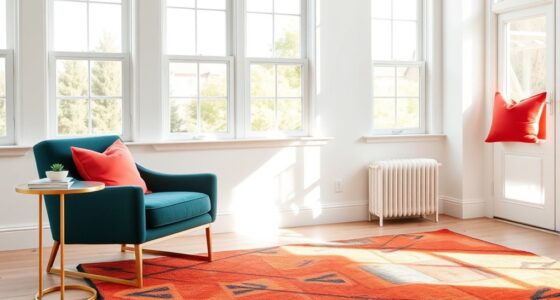To promote wellness in senior living, consider using calming blues for tranquility, nature-inspired greens for relaxation, and grounding browns for stability. Cheerful yellows boost energy, while clean whites symbolize hope and cleanliness. Inspiring purples spark creativity, and warm oranges enhance social interaction. Relaxing blacks create intimate spaces, while earthy tones evoke familiarity and comfort year-round. These colors work together to improve mental well-being and social engagement. Discover how to effectively incorporate these colors into your spaces! In addition to choosing the right colors, it’s essential to implement color tricks for senior safety. For instance, using high-contrast colors on stairs and doorways can help prevent accidents and enhance visibility. Incorporating these design strategies not only creates a pleasing aesthetic but also fosters a safer and more welcoming environment for seniors. By thoughtfully applying these color principles, you can cultivate spaces that are both beautiful and functional, supporting the overall wellness of senior residents.
Key Takeaways
- Blue promotes tranquility and reduces stress, making it ideal for relaxation areas in senior living environments.
- Green enhances mental health and encourages social interaction, fostering a sense of community among residents.
- Brown creates a cozy and secure atmosphere, helping seniors feel stable and relaxed in their surroundings.
- Yellow boosts energy and mood, making it perfect for activity and dining areas to stimulate engagement and appetite.
- Earthy tones evoke stability and comfort, providing a familiar and calming environment throughout the seasons.
The Calming Effect of Blue
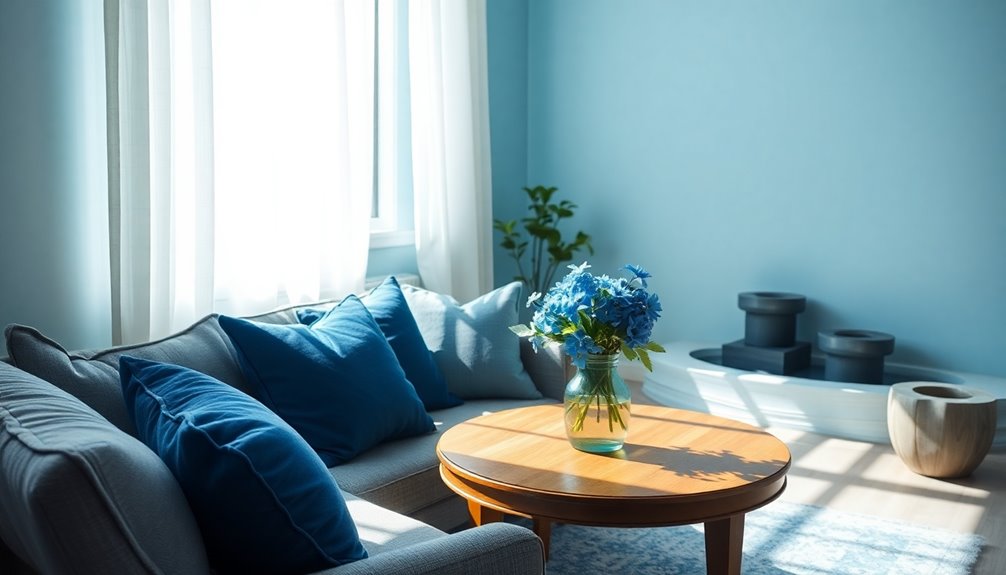
In a world often filled with chaos, the calming effect of blue offers a sense of peace and tranquility that can greatly enhance senior living environments.
This color's association with calmness helps reduce stress and anxiety, creating a serene atmosphere you can thrive in. Exposure to blue can lower your blood pressure and heart rate, contributing to overall wellness. Additionally, incorporating calming colors into your environment promotes better sleep quality, making it perfect for bedrooms and relaxation areas. When balanced with warmer hues, soft shades of blue can invigorate your mental clarity and focus.
Incorporating blue into your surroundings not only soothes the mind but also supports physical healing, ensuring you feel comfortable and at ease in your living space.
Embracing Nature With Green
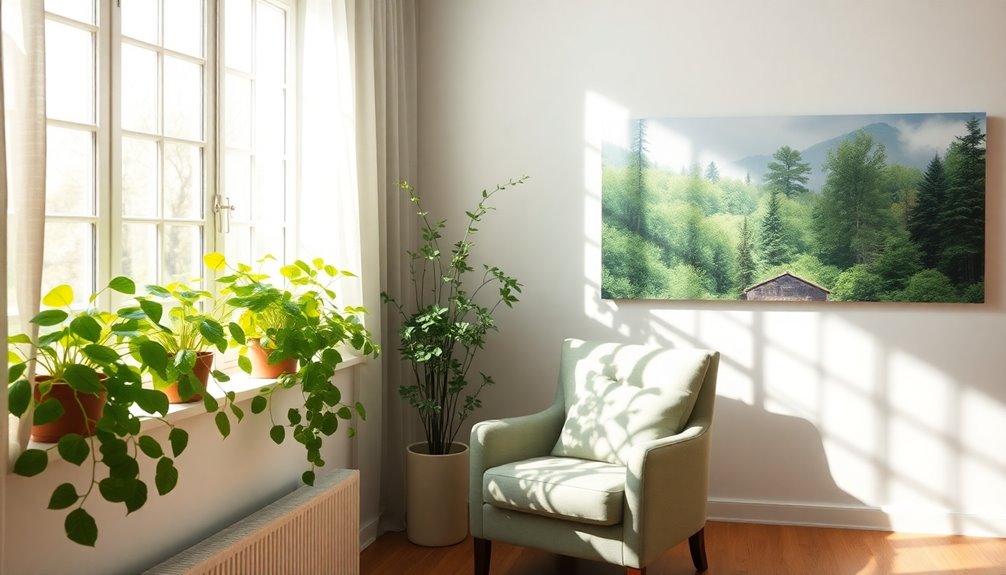
Colors like blue create a soothing atmosphere, but green takes that tranquility a step further by fostering a deep connection to nature. This color brings feelings of comfort and relaxation, making it especially beneficial for residents in urban settings. Deep or emerald green is easy on the eyes, helping to soothe and destress when viewed. Access to green spaces can significantly reduce stress and depression, promoting overall mental health. Additionally, incorporating eco-friendly practices can create a more sustainable environment that enhances the well-being of residents. It also creates a sense of harmony and renewal, enhancing cognitive functions and emotional well-being. Incorporating green in design, like through accent walls or nature-inspired spaces, encourages engagement and social interaction among residents. Embracing green not only beautifies your surroundings but also nurtures wellness and emotional balance in your life.
The Grounding Presence of Brown
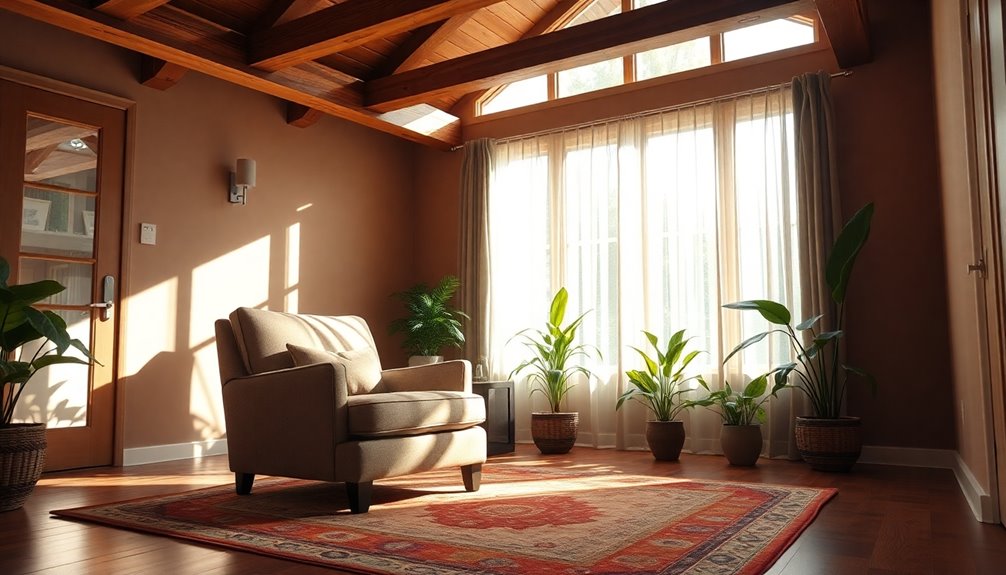
Brown brings a grounding presence to senior living spaces, creating an environment that feels cozy and secure. This calming earth tone fosters stability, making rooms feel tucked away and inviting.
When you incorporate brown into communal areas like living rooms, it cultivates a welcoming atmosphere, especially for seniors who may experience anxiety or stress. The warmth of brown promotes relaxation and tranquility, helping residents feel at ease. Additionally, proper color choices enhance comfort and safety in senior living interiors, further supporting the use of brown as a foundational color. Incorporating natural elements like wood can further elevate the calming effect of brown, creating a more tranquil environment.
You can effectively use brown in tandem with lighter colors to maintain balance and avoid a dark, confined feel. Pairing brown with greens or blues enhances the connection to nature, while its neutrality allows for creativity in design, ensuring a comforting and familiar environment.
The Cheerful Vibe of Yellow
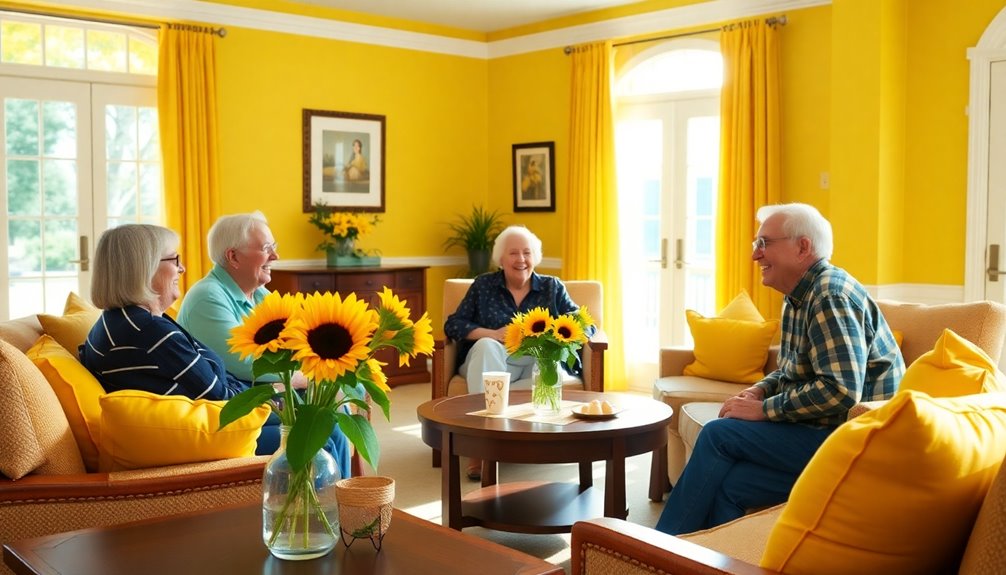
How can a splash of yellow transform a space into a cheerful haven? Yellow boosts energy and alertness, making it perfect for activity areas like game rooms or libraries. This vibrant hue evokes feelings of sunshine and happiness, uplifting everyone's mood. It also encourages regular physical activity, which is essential for maintaining health and well-being in seniors.
It stimulates creativity and optimism, ideal for environments where seniors engage in artistic activities. By using bright yellow accents—like pillows or decorations—you can add a lively touch without overwhelming the space. Soft yellow tones can enhance the mood and perception in dining areas, stimulating appetite and creating an inviting atmosphere. Just remember to balance yellow with cooler colors to avoid irritation, ensuring a harmonious and visually stimulating environment that encourages social interaction and enhances well-being in senior living spaces.
The Clean and Hopeful Essence of White

Purity and clarity define the essence of white, making it a powerful choice for senior living spaces. This color evokes feelings of simplicity, innocence, and freshness, creating an atmosphere of well-being.
You'll notice that white enhances visibility and comfort, making it ideal for walls, ceilings, and floors. A medium-hued white can balance beautifully with other colors, preventing a sterile or clinical feel.
Pairing white with blues or greens invites a sense of restfulness, while warmer whites on walls can enhance overall well-being. It's crucial to consider lighting and the specific purpose of each space when selecting shades of white. With thoughtful combinations, you can ensure that white brings a clean, hopeful essence to your environment. Additionally, using neutral colors can create a sense of clarity and comfort in the overall design.
Energizing Spaces With Red
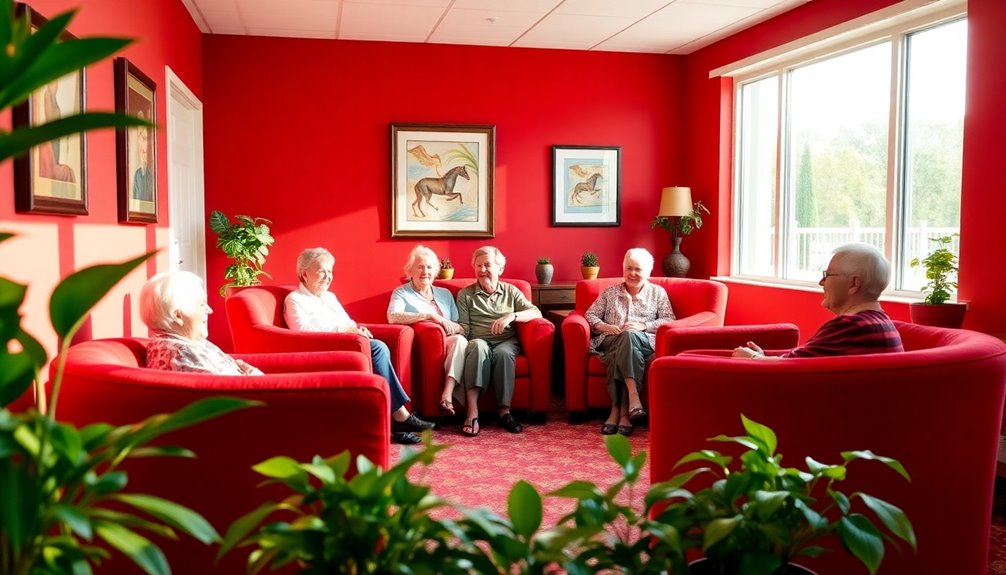
When you think about creating an energizing environment in senior living spaces, red stands out as a vibrant choice. It stimulates appetite, making it perfect for dining areas where residents gather to enjoy meals and socialize. Additionally, intelligent tutoring systems can also be utilized in educational programs for seniors to enhance their cognitive engagement.
Red's energizing effects can enhance alertness, promoting lively interactions in common areas. Additionally, it serves as a visual cue for residents with dementia, helping them navigate essential spaces. Furthermore, contrasting colors help residents differentiate between spaces, ensuring they feel safe and comfortable in their environment.
While red evokes passion and excitement, it's crucial to use it wisely; excessive red can lead to agitation. By incorporating red as an accent color and pairing it with neutrals, you can balance its stimulating qualities.
Enhance lighting to optimize red's impact and create a warm, welcoming atmosphere for everyone.
Creative Inspiration From Purple
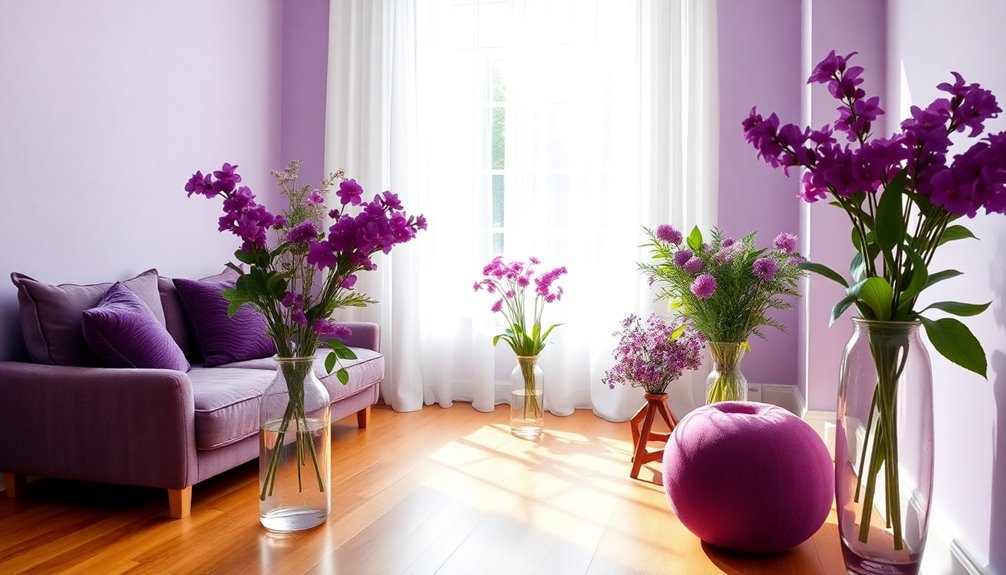
While purple is often associated with luxury and creativity, its true magic lies in its ability to inspire artistic expression. This captivating color stimulates your creative side, making it perfect for activities like painting, writing, and crafting. Color psychology helps to enhance emotional connections, further enriching the creative experience.
When you incorporate lighter shades of purple, you create a dreamy, inviting atmosphere, while deeper tones add drama and sophistication. Using purple in spaces like offices or craft rooms can enhance your artistic pursuits, especially during fall and winter when its richness provides warmth.
Pairing purple with greens or blues can elevate its calming effects, fostering a balanced environment. Ultimately, purple not only adds elegance but also nurtures your creativity, making it an essential color for wellness in senior living.
Social Interaction Boost With Orange

Using orange in senior living spaces can significantly enhance social interaction, as this vibrant color exudes warmth and energy. It stimulates engagement, encouraging residents to participate in communal activities. The bright hue not only evokes excitement but also fosters a welcoming environment, rooted in cultural significance. When used thoughtfully, orange can elevate mood and increase energy levels, combating feelings of fatigue. Additionally, incorporating colour in influencing mental wellbeing can further enhance the overall atmosphere of the space. Color psychology shows that bright colors can uplift spirits and encourage positive interactions. Consider incorporating orange accents in dining areas to boost appetite or in activity rooms to spark enthusiasm. Just remember to balance it with neutral tones, ensuring it remains inviting and not overwhelming. With the right design, orange can truly transform your space into a lively hub for social connection.
The Relaxing Sanctuary of Black
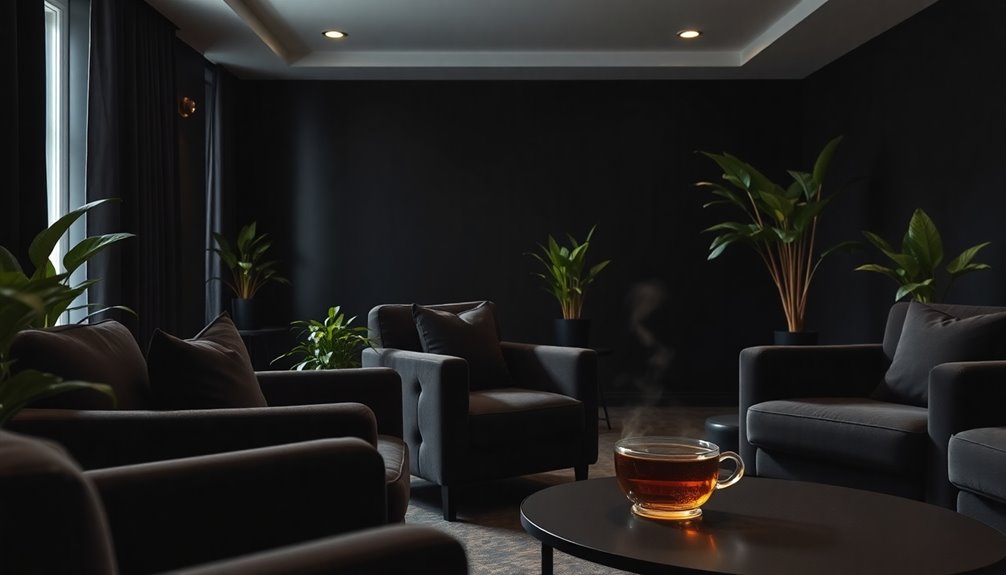
After exploring the vibrant energy of orange in fostering social interaction, let's turn to the calming and sophisticated qualities of black.
This color can create an intimate atmosphere, helping you feel secluded and relaxed, perfect for reading or quiet reflection. When paired with lighter shades, black offers high contrast, enhancing visual clarity for those with declining eyesight. Additionally, it is important for designers to consider the employee discount application process when selecting colors that promote wellness in senior living facilities.
However, be mindful that black walls can make spaces feel smaller, so balance is key. Use proper lighting to prevent overly dark environments.
Incorporating black furniture, textiles, or decor adds elegance and can help define areas. While it promotes relaxation, it's essential to combine black with other colors to avoid overwhelming your senses, ensuring a soothing sanctuary for senior living.
Seasonal Comfort With Earthy Tones
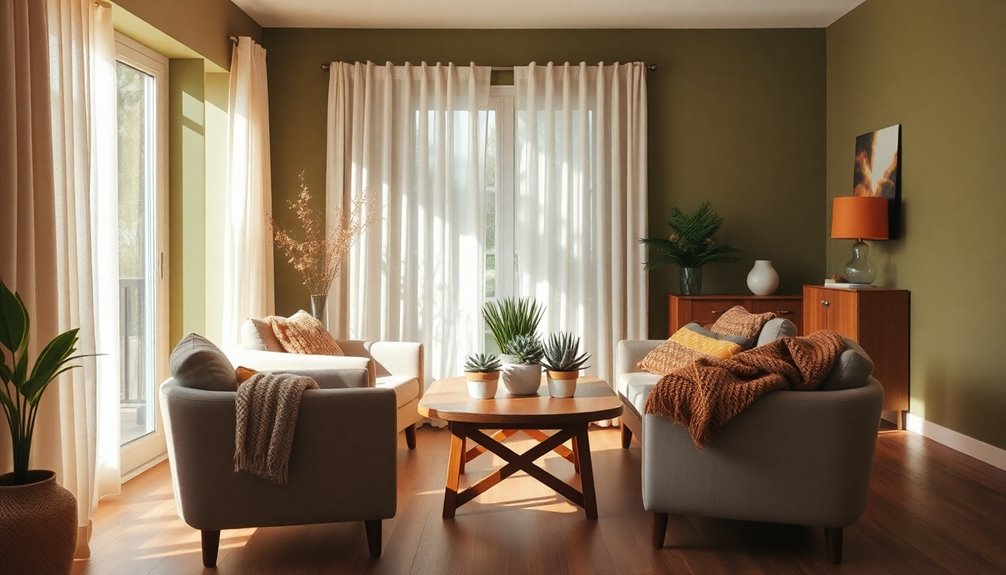
As you explore the calming embrace of earthy tones, you'll discover how these colors can transform spaces into seasonal havens of comfort.
Earthy shades like browns, beiges, and greens evoke the stability of nature, reducing stress and anxiety. During winter, terracotta and sienna bring warmth, while pastel greens and beiges signal spring's renewal. Thoughtful design of communal spaces enhances social interactions, making the use of these colors even more impactful.
In summer, sandy beige enhances vibrancy, and rich olive green and rust create an autumnal coziness. Using these tones consistently fosters familiarity, promoting emotional well-being and social interaction among residents.
Incorporate natural materials and varied textures for depth, and let natural light enhance the inviting atmosphere.
With earthy tones, every season can feel like home, supporting both cognitive and physical health.
Frequently Asked Questions
How Can Color Choices Impact Seniors' Mental Health?
Color choices can significantly impact your mental health.
Calming colors like blue and green help reduce anxiety and promote relaxation, making you feel more at ease. On the other hand, warm colors like orange and yellow can boost your mood and energy levels, fostering social interactions.
When you engage with colors that resonate positively with you, it can enhance your overall well-being and provide a comforting environment tailored to your needs.
Are There Specific Color Preferences Among Different Cultures?
Yes, there are specific color preferences among different cultures.
For instance, blue is universally liked and signifies quality, while red represents passion in the West but luck in Asia.
White is linked to purity in many Asian cultures, whereas yellow conveys happiness in the West and courage in the East.
These preferences reflect how cultural background and historical associations shape your emotional responses to colors, influencing your choices and perceptions daily.
What Colors Are Best for Enhancing Memory in Seniors?
You'd think the color of your walls wouldn't matter much, right?
But if you're looking to enhance memory in seniors, it's crucial. Reds can boost cognitive skills, while blues and greens promote calmness and memory retention.
Mauve creates a tranquil atmosphere, and lemon yellow aids concentration.
By carefully selecting these colors, you can create an environment that not only looks good but also supports better memory function.
Who knew color could be so powerful?
How Do Lighting Conditions Affect Color Perception for Seniors?
Lighting conditions significantly impact your color perception as you age.
You'll find that warmer light reduces glare and enhances clarity, making it easier to distinguish colors. Since your eyes need more light, using task lighting can help direct brightness where it's needed most.
Additionally, high CRI values ensure you see colors accurately, while strategies like glare reduction and uniform light distribution improve your overall visual comfort in everyday activities.
Can Personal Color Preferences Be Incorporated Into Senior Living Designs?
Absolutely, you can incorporate personal color preferences into senior living designs.
By understanding residents' cultural backgrounds and cherished memories, you create spaces that resonate with them. Gathering feedback through surveys allows you to tailor environments effectively.
Offering customization options in personal spaces enhances their sense of control and increases satisfaction.
While managing diverse preferences might be challenging, involving residents in the design process fosters community and ensures their needs are met.
Conclusion
In the quest for wellness, you might think that bold, vibrant colors are the way to go. Ironically, it's often the softer shades that create the true sanctuary you're after. By incorporating calming blues, grounding browns, and earthy tones, you can transform any space into a haven of peace. So, while the bright yellows and fiery reds may shout for attention, it's the subtle hues that whisper comfort and promote well-being in senior living.
References
- https://theclare.com/blog/color-therapy-for-seniors/
- https://www.shakerpainting.com/blog/creating-a-welcoming-atmosphere-why-paint-colors-matter-in-senior-living-spaces
- https://blog.cmbaarchitects.com/applying-color-psychology-in-senior-living-interiors
- https://www.healthdesign.org/sites/default/files/color_in_hc_environ.pdf
- https://risingstarflorida.com/the-colors-you-should-use-in-a-retirement-community/
- https://mhanational.org/surroundings/color-psychology-explained
- https://rcferesource.com/the-psychology-of-paint-colors-in-residential-assisted-living-facilities/
- https://jafedecorating.com/the-tranquil-charm-exploring-the-color-psychology-of-blue/
- https://timesofindia.indiatimes.com/life-style/health-fitness/de-stress/7-relaxing-colors-and-how-they-affect-your-mood/articleshow/46946305.cms
- https://authorityhealth.org/community_health/a-daily-dose-of-the-color-blue-how-seeing-blue-may-help-keep-us-from-feeling-blue/


